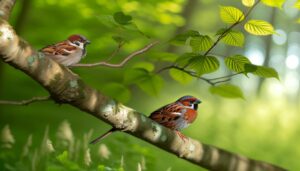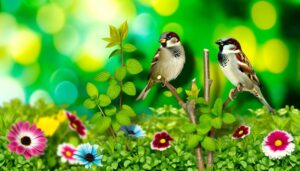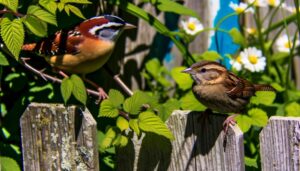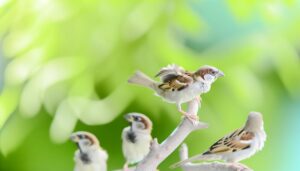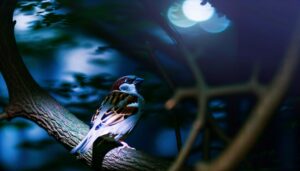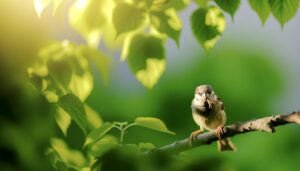How to Attract House Sparrows with a Garden Design
Attracting house sparrows requires a multifaceted approach focusing on proper feeder selection, nutrient-rich seed mixes, and fresh water availability. Utilize platform or hopper feeders with ample perching space and multiple ports, constructed from durable materials.
Provide a diverse seed mix including millet, cracked corn, and sunflower seeds, ensuring essential macronutrients and micronutrients. Regularly clean bird baths and position them in shaded, accessible areas.
Install nesting boxes that mimic natural cavities, protecting from predators and elements. Incorporate horticultural practices to increase local insect populations and avoid pesticides to preserve ecosystem health.
For best sparrow activity, further strategies are essential.
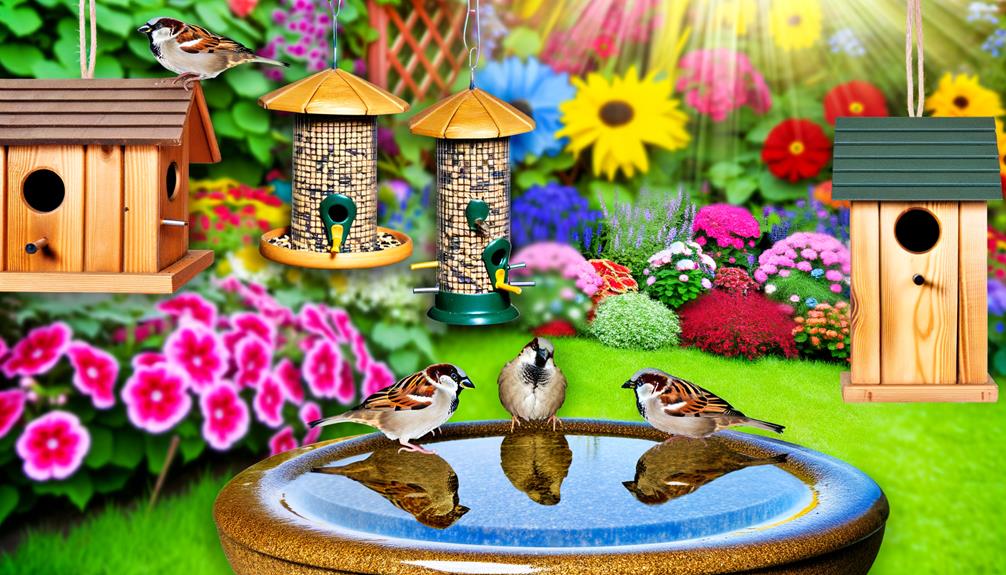
Key Takeaways
- Provide platform or hopper feeders with ample perching space.
- Offer a nutritious seed mix including millet, cracked corn, and sunflower seeds.
- Maintain a consistent supply of fresh water in clean bird baths.
- Install nesting boxes that mimic natural cavities and protect from predators.
- Avoid pesticides and plant native shrubs to increase local insect populations.
Choose the Right Feeder
Selecting an appropriate feeder for house sparrows requires consideration of specific design features that accommodate their feeding behaviors and dietary preferences. House sparrows (Passer domesticus) exhibit a strong preference for platform feeders and hopper feeders, which offer ample perching space. These feeders should be equipped with multiple ports to facilitate simultaneous feeding, as house sparrows are highly social and often feed in flocks.
The feeder material should be durable and resistant to weather conditions, ensuring longevity. Additionally, incorporating a roof or cover can protect the feed from moisture, thereby maintaining its quality. Proper feeder placement is critical; positioning the feeder at a moderate height and in a quiet, sheltered area will attract more house sparrows by providing a sense of security against predators.
Offer Nutritious Seeds
Providing house sparrows with a diet rich in nutritious seeds is crucial for meeting their energetic and nutritional needs. These seeds offer a diverse range of macronutrients and micronutrients important for their health and well-being.
The following are key components of an effective seed mix:
- Millet: High in carbohydrates, aiding in energy provision.
- Cracked Corn: Supplies essential proteins and fats.
- Sunflower Seeds: Rich in fatty acids, promoting feather health.
- Canary Grass Seed: Contains crucial amino acids for growth and repair.
Provide Fresh Water
Ensuring a consistent supply of fresh water is essential for attracting house sparrows, as hydration is vital for their daily physiological functions.
Proper bird bath maintenance, including regular cleaning and timely refilling, is necessary to prevent waterborne diseases.
Additionally, strategically placing water sources in shaded and accessible locations will optimize their visibility and usage by the birds.
Bird Bath Maintenance
Regularly upkeeping a bird bath by providing fresh, clean water is crucial for attracting and sustaining a healthy population of house sparrows. This practice guarantees that the water remains free from contaminants, reducing the risk of disease transmission among avian visitors. Observational data indicate that sparrows are more likely to frequent well-maintained water sources.
Key maintenance tasks include:
- Daily water change: Prevents stagnation and the growth of algae.
- Routine cleaning: Use a brush and mild detergent to eliminate biofilm and debris.
- Regular inspections: Check for cracks or leaks that could jeopardize water quality.
- Winter adjustments: Utilize a heated bird bath or de-icer to maintain access during freezing temperatures.
These measures secure a consistent, hygienic water supply, thereby promoting the well-being of house sparrows.
Water Source Placement
Proper placement of water sources is crucial in attracting house sparrows, as it greatly influences their accessibility and safety. Guaranteeing the water source is positioned at an elevation reduces the risk of predation and contamination. Proximity to vegetation provides cover, enabling sparrows to approach and retreat safely. Regularly replenishing and cleaning the water source sustains a consistent, fresh supply, which is vital for sparrow hydration and bathing.
| Parameter | Recommendation | Purpose |
|---|---|---|
| Elevation | 3-4 feet above ground | Safety from predators |
| Proximity | Near shrubs or trees | Shelter and quick escape routes |
| Water Quality | Fresh, changed daily | Health and hygiene |
| Material | Non-toxic, shallow containers | Accessibility and safety |
Careful adherence to these parameters will notably enhance the attractiveness of the water source to house sparrows.
Install Nesting Boxes
Installing nesting boxes designed to mimic the natural cavities preferred by house sparrows can greatly enhance their likelihood of habitation. These avian species exhibit a noticeable preference for enclosed spaces that offer protection from predators and environmental elements.
Best-suited nesting boxes should adhere to the following specifications:
- Dimensions: Interior dimensions of about 12 x 12 x 20 centimeters.
- Entrance Hole: A circular entrance hole with a diameter of 3.5 centimeters.
- Placement Height: Positioning the box at a height of 2 to 4 meters above ground level.
- Orientation: Facing the entrance away from prevailing winds to minimize exposure.
These technical considerations are crucial in replicating the sparrows' indigenous nesting conditions, thereby encouraging them to adopt human-facilitated habitats. Employing these measures will notably increase the probability of successful sparrow colonization.
Maintain Clean Feeders
Maintaining the cleanliness of bird feeders is crucial in preventing the spread of diseases among house sparrow populations. Residual feed, moisture, and fecal matter can harbor pathogenic microorganisms like Salmonella spp., avian poxvirus, and Mycoplasma gallisepticum.
To address these risks, feeders should be cleaned every two weeks using a solution of one part bleach to nine parts water, followed by thorough rinsing and drying to remove chemical residues.
Observational data show that regular cleaning reduces infection rates and supports healthier sparrow gatherings.
Furthermore, feeders should be positioned in shaded areas to reduce mold growth and be routinely checked for structural damage to avoid contamination. Proper maintenance of feeders thus guarantees a clean feeding environment that attracts sparrows.
Create a Safe Environment
In addition to maintaining clean feeders, creating a safe environment involves strategic placement of feeders and nesting boxes to protect house sparrows from predators and extreme weather conditions.
Ensuring the best safety of these birds requires meticulous site selection and structural considerations. Key strategies include:
- Elevated Positioning: Place feeders and nesting boxes at least 5-6 feet above ground to deter terrestrial predators.
- Weather Sheltering: Situate these structures in locations providing natural windbreaks, minimizing exposure to harsh elements.
- Proximity to Cover: Position near dense foliage or shrubbery, offering immediate refuge from aerial predators.
- Predator Guards: Install baffles or guards on poles to prevent climbing predators from accessing the feeders or nesting sites.
Such measures collectively foster a secure habitat, encouraging house sparrows to thrive.
Plant Native Shrubs
Planting native shrubs is instrumental in providing essential shelter options for house sparrows, thereby enhancing their habitat suitability.
These shrubs also contribute to an increase in insect population, a critical food source for sparrows, by supporting a diverse ecosystem.
Consequently, the integration of native flora fosters a balanced environment conducive to the thriving of house sparrows.
Provide Shelter Options
Native shrubs serve as significant microhabitats, providing both refuge and foraging opportunities essential for the sustenance of house sparrows. The structural complexity of these plants supports diverse ecological functions, including nesting sites and protection from predators.
Key benefits of native shrubs include:
- Seasonal Food Sources: Native shrubs often produce berries and seeds that sparrows consume.
- Nesting Material: The foliage and branches provide essential materials for nest construction.
- Shelter from Elements: Dense foliage offers protection from harsh weather conditions.
- Biodiversity Support: They host a variety of insects and other small organisms, enhancing the local ecosystem.
Strategically planting a variety of native shrubs can create an ideal habitat, increasing the likelihood of attracting and sustaining house sparrow populations.
Increase Insect Population
Regularly incorporating a diverse array of native shrubs into garden landscapes can enhance the local insect population, which serves as a critical food source for house sparrows. Native shrubs attract a variety of insects native to the region, increasing biodiversity and creating a balanced ecosystem. These shrubs provide shelter and breeding grounds for insects, which in turn become prey for house sparrows. Scientific studies have demonstrated that native plants support more insect species than non-native plants.
| Native Shrub Species | Attracted Insect Types |
|---|---|
| Dogwood | Beetles, Butterflies |
| Elderberry | Bees, Moths |
| Serviceberry | Aphids, Leafhoppers |
| Viburnum | Caterpillars, True Bugs |
Avoid Pesticides
Eliminating the use of pesticides is vital to maintaining a healthy ecosystem that supports the thriving population of house sparrows. Pesticides, including insecticides and herbicides, disrupt the food web by reducing the availability of insects, a pivotal food source for sparrows. Additionally, chemical residues can contaminate the environment and pose direct toxicity risks to birds.
Key considerations include:
- Biodiversity: Preserving a diverse range of insect species ensures ample food supply.
- Soil Health: Organic farming practices enhance soil microbiota, indirectly benefiting avian species.
- Water Quality: Minimizing chemical runoff reduces contamination of water sources used by wildlife.
- Plant Health: Promoting native plant species can naturally control pest populations without harmful chemicals.
Add Bird Baths
In addition to minimizing pesticide usage, providing bird baths can greatly enhance the habitat for house sparrows by offering a reliable water source for drinking and bathing.
House sparrows (Passer domesticus) exhibit frequent hydration and cleanliness behaviors, necessitating the availability of clean water. A bird bath with a shallow basin, approximately 1-2 inches deep, is best suited to accommodate their size and prevent drowning.
Placement in a shaded area can reduce water evaporation and algal bloom growth, ensuring water quality. Regular cleaning is essential to prevent pathogen transmission.
Incorporating a dripper or mister can simulate natural water sources, attracting sparrows through sound and movement. Therefore, strategically placed and well-maintained bird baths play a key role in the welfare of house sparrows.
Offer Grit and Sand
Providing a consistent supply of grit and sand is crucial for the digestive health of house sparrows, as these materials aid in the mechanical breakdown of seeds within their gizzards. Grit, typically composed of small stones and coarse sand, facilitates efficient digestion by grinding food particles, thereby enhancing nutrient absorption.
Observations indicate that sparrows actively seek out these materials in natural habitats. To achieve an ideal availability, consider the following:
- Grit Type: Offer a mix of fine gravel and crushed oyster shells.
- Placement: Position grit in shallow dishes or scatter on the ground.
- Frequency: Regularly replenish supplies to maintain consistency.
- Hygiene: Make sure grit containers are clean to prevent disease transmission.
These measures will create an environment conducive to the well-being of house sparrows.
Monitor and Adjust
Regular monitoring of the sparrows' feeding and nesting habits is necessary to ensure their needs are met and to make necessary adjustments to the provided resources. Observing the frequency and duration of visits to feeders, as well as the types of seeds consumed, can offer insights into their dietary preferences. Additionally, inspecting nesting boxes for occupancy and condition is essential for ensuring a conducive breeding environment. Utilize the following table to record and analyze key observations:
| Parameter | Observation Frequency | Suggested Adjustment |
|---|---|---|
| Seed Consumption | Weekly | Adjust seed variety |
| Nest Box Usage | Bi-weekly | Clean or replace boxes |
| Bird Health | Monthly | Provide fresh water sources |
Consistent documentation aids in creating an ideal habitat for house sparrows.
Conclusion
The juxtaposition of thoughtfully chosen feeders and nourishing seeds with the harmful effects of pesticides highlights the delicate balance needed to attract house sparrows effectively.
The provision of fresh water and bird baths, along with the installation of nesting boxes and offering of grit and sand, creates an ideal habitat.
Keeping feeders clean and consistently monitoring conditions guarantee sustainable attraction.
This thorough approach underscores the complex interplay between environmental stewardship and bird attraction.

